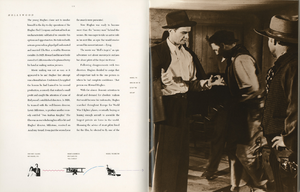Search the Special Collections and Archives Portal
Search Results

Transcript of interview with Mike, Fred, & John Pinjuv by Barbara Tabach, May 13, 2014
Date
Archival Collection
Description
Mike Pinjuv sired one of Las Vegas’s early families after arriving in 1917. Mike Pinjuv arrived in Las Vegas via the Union Pacific Railroad and brought Ivan Pinjuv and his family to town (although Mike’s sons do not know the familial relation between the two men). Mike and his wife, Frances Malner, raised six sons and two daughters to adulthood through World War 1, the Great Depression, and World War II. The oldest five brothers attended Las Vegas High School, while Fred, the youngest brother, and the two sisters attended Rancho High School. In this interview, their three younger sons recall how they, their parents, and their siblings navigated the social and physical changes in the Las Vegas landscape. Over the near century that the Pinjuv family has lived in Las Vegas its members have contributed to the city in countless ways. In the early years Mike owned a gas station and a grocery store and worked several jobs before going to Nellis Air Force Base as a civilian. Of the Pinjuv sons
Text

Interview with David Browning Thomson, April 12, 2005
Date
Archival Collection
Description
Text

Interview with Lawrence Crooks, July 21, 2004
Date
Archival Collection
Description
Text
Maxine Buckles oral history interview
Identifier
Abstract
Oral history interview with Maxine Buckles conducted by Irene Rostine on September 20, 1995 for the Women's Research Institute of Nevada (WRIN). In this interview, Buckles discusses her life in Boulder City, Nevada in the 1930s and 1940s. She talks about her high school years, working for a bank, and working for the Rheem Manufacturing Company at the Basic Magnesium Incorporated (BMI) industrial complex during World War II. Buckles describes working conditions for women, unions, and security at the BMI industrial complex.
Archival Collection
Dan Bennett oral history interview
Identifier
Abstract
Oral history interview with Dan Bennett conducted by Guy Pence on October 03, 1972 for the Ralph Roske Oral History Project on Early Las Vegas. During this interview Bennett talks about the visits from presidents and other important people to the Las Vegas, Nevada area and discusses the 1942 plane crash of Carole Lombard’s plane. He also mentions Boulder Dam and describes the economic, social and environmental changes that have taken place in Southern Nevada over the years.
Archival Collection
Donn Blake oral history interview
Identifier
Abstract
Oral history interview with Donn Blake conducted by George Kostic on April 17, 1980 for the Ralph Roske Oral History Project on Early Las Vegas. Blake discusses his role as a Special Projects Coordinator for the City of Las Vegas, Nevada and the various roles he held in historical preservation. Blake also discusses how Las Vegas has grown and evolved over the years. He describes the changes in airport locations over time and mentions the need for historical preservation.
Archival Collection
Suzette Cox oral history interview
Identifier
Abstract
Oral history interview with Suzette Cox conducted by Lance Cooper on March 01, 1979 for the Ralph Roske Oral History Project on Early Las Vegas. In this interview Suzette Cox discusses working at the Las Vegas Sun, a local newspaper, as a deputy sheriff, and at the University of Nevada, Las Vegas as a secretary. She also talks about living in Las Vegas, Nevada, the Las Vegas Strip, gambling, recreational activities, atomic testing, the Mormon Fort, and how Las Vegas has changed over the years.
Archival Collection
L. J. Bowman oral history interview
Identifier
Abstract
Oral history interview with L. J. Bowman conducted by Lidia Sedano on October 11, 2004 for the Public School Principalship Oral History Project. In this interview, Bowman discusses his upbringing and path to becoming a teacher during the 1970s. He discusses his experience as a teacher in Wisconsin and in Montana, but highlights his 17 years as principal in various Montana school districts prior to becoming a teacher in the Clark County School District in the 1990s. He discusses his personal philosophy of education, and how it influenced his career as an administrator. He also discusses highlights and challenges of his career, and provides suggestions on what makes a successful principal.
Archival Collection

Transcript of interview with Diana Saunders by Barbara Tabach, April 17, 2017
Date
Archival Collection
Description
Diana Saunders was born Diana Salshutz in the Bronx, the northern most borough of New York City. She was raised in a Jewish neighborhood and recalls how her maternal grandparents pickled pickles, tomatoes and other traditional Jewish delicacies for Wolfie?s Deli. By the time she was twelve years old, Diana was bustling through the city to pursue her dream of becoming a professional dancer. Encouraged by her mother Rose?her father Sidney was not as eager for this pursuit?Diana was accepted into High School of Performing Arts in Manhattan. In addition, she was accepted at the School of American Ballet where she studied classical ballet during the leadership of renowned choreographer George Balanchine. Her first professional performance was in the Nutcracker for American Ballet. At the age of seventeen, Diana was on her own, confident in her dancing potential, and eager to study jazz dancing. This led her to Matt Mattox and to her important mentor, Luigi (Eugene Louis Faccuito). In time she was a featured dancer for Steven Lawrence and Eydie Gorm?s show Golden Rainbow. This was soon followed by a position on Sammy Davis Jr.?s television show in the 1960s. Diana also studied musical acting and showed talent for comedic performance. In the 1970s, Diana crossed paths with Las Vegas venues. She relocated to Las Vegas in 1974 when Donn Arden offered her a dancer position in Hallelujah Hollywood at the MGM. She met and married musical theater actor/singer Joe Bellomo, whose career spanned four decades. He passed away of complications of early onset Alzheimer?s in 1996. Always true to her personal mantra?Wake up; Dress up. Show up?Diana maintains a busy schedule. At the time of this of this interview, she is currently a manger of gondoliers at the Venetian. She brings to life that career and also talks about being a part of the former Star Trek Experience at the Las Vegas Hilton. Diana shares stories of long career as a dancer, from substituting in the black dancer line to continued study of dancing with Anglo Moio. She also talks about the AIDS fundraising event Golden Rainbow, having dinner at Rabbi Shea Harlig?s home and observations of local theater.
Text

